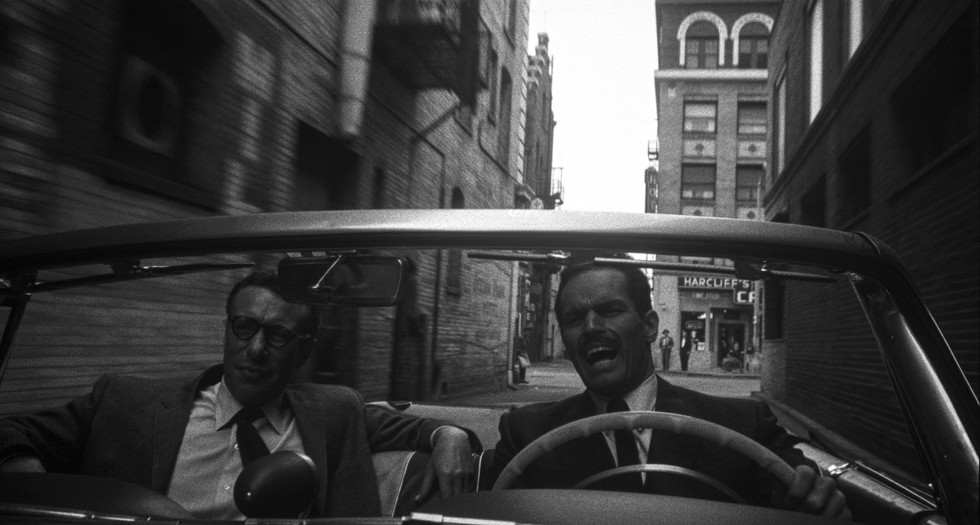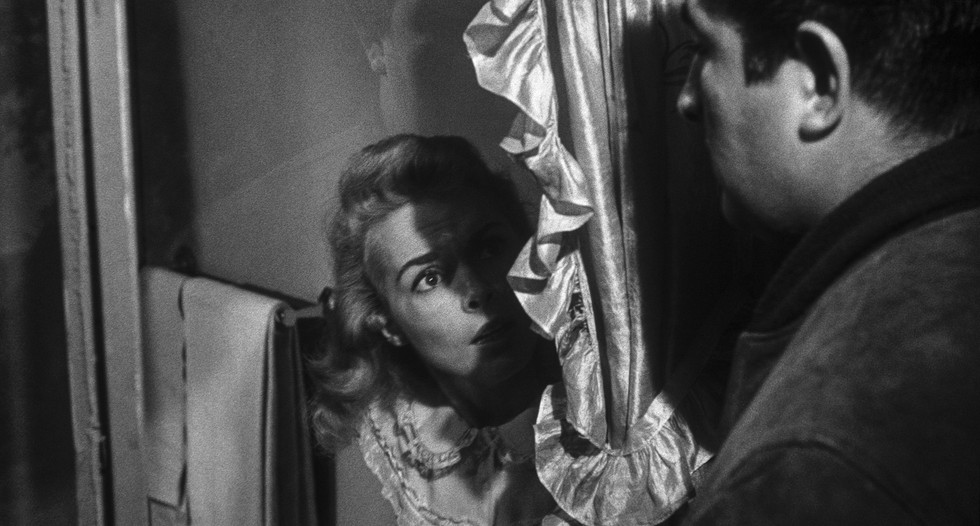Film noir masterpiece “Touch of Evil” on 4K UHD
- Bill Kelley III

- Feb 28, 2022
- 8 min read
Updated: Jun 15, 2022
4K ULTRA HD REVIEW / HDR FRAME SHOTS

Writer/director/actor Orson Welles plays corrupt, unshaven police captain Hank Quinlan on the U.S. and Mexico border.
(Click on an image to scroll through the larger versions)
“TOUCH OF EVIL”
4K Ultra HD; 1958; PG-13 for some violence and drug content
Best extra: Yes, three versions – A “Preview” cut discovered in 1976, “Theatrical” from 1958, and Orson Welles’ “Reconstructed” edit 1998 on three 4K discs
ORSON WELLES knew it wasn’t going to be pretty.
Hollywood’s most misunderstood auteur watched a re-edit of his upcoming thriller, “Touch of Evil.” Universal wasn’t pleased; Universal Studios had taken his film, removed a number of scenes, and reshot others. Director/writer Welles didn’t take a single note that night, film preservationist Rick Schmidlin says during one of the five commentary tracks included in the Kino Lorber package. But when he got home, Welles banged out a passionate 58-page memo with a laundry list of demands. First, “I assume that the music now backing the opening sequence of the picture is temporary....” On the final page: “I close this memo with a very earnest plea that you consent to this brief visual pattern to which I gave so many long, hard days of work.”
As expected, Universal ignored him.
Reading the memo, one senses how committed Welles was to preserve his vision. It painstakingly takes us, scene-by-scene, through the film and points out every single glitch. Universal provided a copy of the typed memo with its 2014 Blu-ray. It’s not available with this 4K set from Kino Lorber. That’s a shame.
Finally, in 1998, Universal dredged up Welles’ memo and honored his posthumous wishes. The film was restored by 13 minutes, with many sound effects and cuts reinstated. The much-praised and highly debated opening shot – filmed without a cut for three-and-a-half minutes – was restored without opening credits inserted over the action, while Henry Mancini’s jazzy overture was replaced with natural sound.
Opening tracking shot - Reconstructed edit
More likely a third-generation international print without titles was used for the three and half minute opening shot. The image is softer and the film grain is less defined with the egg timer bomb and Mike and Susan Vargas (Charlton Heston and Janet Leigh) embracing as the car explodes.
Opening tracking shot - Theatrical & Preview edits
The two edits feature a much sharper image and a more defined film grain structure during the opening shot with titles.
Mancini’s score has developed a large following over the years. The up-and-coming composer assembled a jazz lineup with Red Norvo vibes, featuring Shelly Manne on drums, Barney Kessel on guitar, and Jack Costanzo on bongos. Filmmaker and author F.X. Feeney calls the overture “sensational” in his commentary on the theatrical version – the shortest of the three edits at 95-minutes.
Feeney also provides a frame-by-frame description of Welles’ complex master shot – one of cinemas’ greatest. Filming took place among the arches of the Venice, CA, business district. For Welles and his crew, it was an all-day affair just rehearsing camera movements that stretched over five city blocks. That night, with a cast of hundreds, the orchestrated shot wrestled with endless hiccups. They finally nailed it just as the sun began to rise – the camera moving like a “winged serpent over the rooftops and streets of the mythical U.S. and Mexican border town of Los Robles," Feeney says.
The shot opens with the camera tightly framed on an egg timer set for three-and-a-half minutes strapped to a bomb. The shadowy killer places it in the trunk of a car, while the camera zooms up and over, picking up honeymoon couple Mike and Susan Vargas (Charlton Heston and Janet Leigh) walking toward the border crossing. At the checkpoint, the car passes and the tension builds. Seconds later – boom!
(1&2) The honeymoon couple are greeted by a U.S. Customs agent at the border. At the checkpoint, the car with Rudy Linnekar (Jeffery Green), a local construction magnate, and his female companion Zita (Joi Lansing) pass, and seconds later – boom! (3) Susan is confronted by Pancho (Valentin De Vargas), who works for ‘Uncle’ Joe Grandi, a small-time crime boss. (4) The corner (Joseph Cotten) and other officials examine the dead bodies. (5) Right, Capt. Quinlan and Sgt. Pete Menzies (Joseph Calleia) arrive at the scene.
Based on the 1956 pulp crime novel “Badge of Evil,” Welles plays corrupt, unshaven cop Hank Quinlan, wearing 60 pounds of extra padding. Heston is oddly cast as a Mexican drug agent, and Leigh his blonde bride from Philadelphia. An excellent supporting cast includes Dennis Weaver as a bizarre motel clerk, Russian-born Akim Tamiroff as ‘Uncle’ Joe Grandi, an uncredited Mercedes McCambridge as a gang leader, and a surprise cameo from Marlene Dietrich, playing the fortune-telling madam of a Mexican brothel and Quinlan’s former lover. The studio had no idea the legendary starlet was on the bill.
VIDEO
Universal handled the black and white 4K restoration, with all three edits mastered in True 4K. It seems the original camera negative or a duplicate negative (1.85:1 aspect ratio) was used for the majority of footage for the “Theatrical” cut, and a second or third-generation source for the added “Preview” and “Reconstructed” scenes. Still, Welles frames most of the action with his trademark wide-angle perspective. Close-ups look superb and clarity is several notches better than the previous Blu-ray, with natural film grain showing more definition.
Welles hired longtime friend Russell Metty (“The Stranger,” “Spartacus”) as his cinematographer, introducing American cinema to the much smaller Éclair Cameflex camera, giving “Touch of Evil” its famed handheld and wide-angled low vantage point perspective.
A couple of scenes from the “Reconstructed” edit struggle with source issues. The opening sequence without the credits was scanned from an international print, and suffers from a slightly softer image. It’s barely sharper than the previous Blu-ray, just for those 3½ minutes. On the other hand, the “Preview” and “Theatrical” cuts are much sharper, also showing a good dose of grain. Another problematic scene is when Susan Vargas is taken to a motel on the edge of town by police Sergeant Pete Menzies (Joseph Calleia) during the “Reconstructed” and “Preview” edits. The damaged print has vertical scratches and unevenly developed marks on one side of the frame. Imperfections have been around for two decades and have never been digitally repaired.
(1) At Grandi’s headquarters, Susan says, “You know what's wrong with you, Mr. Grandi? You’ve being seeing too many gangster movies. Mike may be spoiling some of your fun.” Grandi responds, “Mike?” “My husband, yeah! And if you’re trying to scare me into calling him off, let me tell you something Mr. Grandi. I may be scared, but he won’t be.” she says. (2) Extreme wide-angle close-ups are a part of Welles trademark filmmaking. (3) Pancho and ‘Uncle’ Joe Grandi (Akim Tamiroff). (4) The investigation team includes Quinlan, District Attorney Adair (Ray Collins), Sgt. Menzies, assistant D.A. Al Schwartz (Mort Mills) and Blaine (Phil Harvey).
Kino and Universal provide HDR10 and Dolby Vision grading on all three edits. The overall grayscale is more stable, with darker blacks, while providing expanded shadow detail, and controlled and detailed highlights.
During the “Bringing Evil Up” featurette, the late cinematographer Allen Daviau (“E.T. the Extra-Terrestrial,” “The Color Purple”) says the film, “influenced our whole generation of cinematographers.” He viewed it over 20 times, “because it was such a compendium of editorial techniques, let alone photographic techniques.”
Overall clarity and sharpness are several clicks above the previous Blu-ray, nearly matching Kino/MGM 4K restoration for “Some Like it Hot,” which was mostly sourced from the camera negative. The video runs mostly over 80 megabits per second on all three edits.
AUDIO
The original 2.0 mono track has been restored, removing pops and hiss to provide a clean, front and center soundtrack.
(1) Looking for answers Quinlan ends up at a local strip club, where Zsa Zsa Gabor plays the club owner. (2) Marlene Dietrich, playing Tana, the fortune-telling madam of a Mexican brothel and Quinlan’s former lover. (3) Quinlan, District Attorney Adair, and Mike Vargas the Mexican head of the Pan-American Narcotics Commission. The bombing may be the work of Grandi’s narcotics ring. (4) One of the additional shots made by Universal substitute director Harry Keller. (5) Vargas decides to send Susan to a small motel on the American side of the border as he continues working the bombing case. Unknown to him, the motel is owned by Grandi.
EXTRAS
The discs include two carry-over featurettes, “Bringing Evil to Life” and “Evil Lost and Found,” with interviews from film historian/director Peter Bogdanovich (“The Last Picture Show”), and cast members Leigh, Weaver, and Heston, who mentions how he convinced Universal that Welles should be the director since he had already been signed to play Quinlan. Heston chuckles, saying, “He’s a pretty good director.” Bogdanovich, who interviewed Welles numerous times said, “Welles didn’t really know why the studio turned against the film.”
Five more commentaries are spread over the three versions. The best with Schmidlin, Heston and Leigh is found on the “Reconstructed” version. It tells how Welles, on the first day of filming, shot 13-pages of the script – normally three days of work – to get studio executives off his back. It’s now known as the five-minute “shoebox” scene, mostly captured in a single shot. The handheld camera weaves in and out and through several rooms, as a dozen-plus actors enter and exit the frame. “It’s a remarkably long take…and this room is going to get about as crowded as that shipboard scene in the [Marx Brothers’] “Night at the Opera,” says Welles' historians Jonathan Rosenbaum and James Naremore in the “Preview” commentary.
There’s a new track with author/film historian Imogen Sara Smith, who’s been one of Criterion Collection’s go-to essayists and interviewers over the last seven years. She calls the “Reconstructed” edit the “Memo” version, incorporating 48 changes. Smith is still amazed by the opening shot. “It’s so carefully crafted, yet it feels so exhilarating and so spontaneous, and repulsive. It immerses us immediately into Los Robles and its mingling clashes of cultures.”
(1) Vargas, Schwartz, and Quinlan end up at a construction site seeing if any dynamite had been missing. (2) Dennis Weaver plays a bizarre motel clerk. (3) The now-famous 'shoebox’ scene and its continuous five-minute shot. (4) Vargas calls the Mirador Motel to speak to his wife. (5) A Hollywood first: mounting a camera on the front of a car and capturing the actors driving. Vargas races down an alleyway, as Heston started and stopped the camera.
Novelist/critic Tim Lucas provides a new set of eyes on the “Theatrical” cut, which he first watched in 1974. His commentary first highlights the film's financial numbers; budgeted for $829,000, it ran over $300,000. “Touch of Evil” only grossed $2.2 million, and with its promotional and printing budget, it barely made a profit. But, over time “Touch of Evil” found an audience and became a classic.
A young, impressionable filmmaker, François Truffaut, called “Touch of Evil” “a magical film” in a review he wrote for a French publication only months before he began directing his first masterpiece, “400 Blows.”
“Touch of Evil” was selected No. 57 by the British Film Institute/Sight and Sound Magazine Top 100 global movies ever made. Strangely, it wasn’t picked for the American Film Institute’s top 100 list of American films.
There's no doubt Welles’ “Touch of Evil” is a magnificent evening of crime and suspense no matter which version you watch.
— Bill Kelley III, High-Def Watch producer
(1) Vargas and Schwartz continue the investigation. (2) Susan is attacked and drugged by Grandi's gang to frame Vargas. (3) He finds Susan jailed on suspicion of drug use and prostitution. (4&5) The final battle between Vargas and Quinlan.




























































One Amazing Release!! If you enjoy this film and need all the gold, it's all right there!!! So, glad the 3 versions are assembled in one set...definatly a days viewing , to do a direct comparrison study of all three in one sitting...bring out the Tequila and chips!!!
Great review, super in-depth. Love it - HD MOVIE SOURCE.